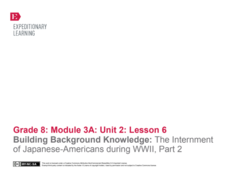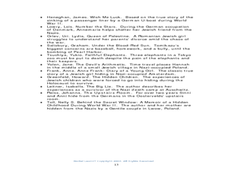US National Archives
WWII: Mediterranean and N. Africa 1939-45 – Where Will the Allies Invade?
An interactive asks learners to act as German intelligence agents and examine documents found on the body of an English soldier wash ashore on the cost of Spain. Using the documents, the agents are asked to predict where the Allies were...
US National Archives
WWII: Mediterranean and N. Africa 1939-45 – Monty
Is Field Marshal Montgomery the right man to command the land forces in France for D-Day? That's the question facing young historians as they explore an interactive resource that focuses on the Mediterranean and North Africa theatre from...
US National Archives
WWII: Asia 1939-45 – Burma
Because World War II encompassed most of the globe in one way or another, many pivotal battles and events are not as visible in the history books, leaving veterans of these conflicts feeling overlooked by more famous skirmishes. High...
US National Archives
WWII: Asia 1939-45 – Singapore
The fall of Singapore in World War II was shocking news for the Allied forces—but why? High schoolers explore primary source documents and videos to determine why February 15, 1942 was a wake-up call to the British Empire and its allies...
US National Archives
WWII: The Pacific 1939-45 – Iwo Jima
Of the images that have permeated history to define American courage, perseverance, and patriotism, the 1945 photograph of United States Marines raising the flag at Iwo Jima is one of the most well known. After researching the pivotal...
US National Archives
WWII: The Atlantic 1939-45 – Battle of the Atlantic
The most dangerous line of attack during World War II wasn't the German planes soaring above Britain, but the U-Boats cutting off their supplies of food and equipment. Learners research the Battle of the Atlantic, the German campaign to...
US National Archives
WWII: The Pacific 1939-45 – Pearl Harbor
Though December 7th, 1941 was a day "which would live in infamy," World War II had provided many infamous days, events, battles, and atrocities in the years before. So why were American forces so surprised when Japan attacked Pearl...
US National Archives
WWII: The Pacific 1939-45 – Japan and the Atom Bomb
Though the scientists who developed the atom bomb did not believe it should be used to end World War II, American President Harry S. Truman and British Prime Minister Winston Churchill were of like mind in their decision to drop the bomb...
EngageNY
Analyzing a Thematic Concept: The Invisibility of Captives during WWII (Pages 182-188)
Readers complete a word web-based on the word dignity. They use their Understanding Invisibility note catcher to discuss how dignity relates to the theme of invisibility. After group discussion comparing invisibility and loss of dignity,...
EngageNY
Introducing a Thematic Concept in This Unit: The “Invisibility” of Captives during WWII (pages 170-181)
Scholars discuss the phrase identity is erased and how it relates to the theme of invisibility. They use their Understanding Invisibility note catcher to identify how invisibility may occur within a person. They then work on a Gathering...
EngageNY
Building Background Knowledge: The Internment of Japanese-Americans during WWII, Part 3
Check those sources carefully. Scholars learn to analyze and critique primary sources with the work they completed in the previous activity. Learners compare and contrast sources that agree and disagree about Japanese-American internment...
EngageNY
Building Background Knowledge: The Internment of Japanese-Americans during WWII, Part 2
Scholars learn about primary sources with a Primary Sources: Japanese-American Internment during World War II packet. Pupils work with a partner to read challenging sources in the packet while making notes in the margins. They then...
EngageNY
Analyzing Theme: The Invisibility of Captives during WWII
Can you see me now? Scholars discuss two definitions of invisibility and then connect the definitions to text evidence related to Louie's invisibility in Unbroken. Readers turn their attention to The Life of Miné Okubo and record text...
Curated OER
Legends of Airpower: Aviation-Then, Now and Here
Students examine the advancements made in aviation during and since WWII. They read an interview with Charles McGee, research a plane, build a model of a plane, and develop a Powerpoint presentation about aircraft.
Curated OER
Under the Blood-Red Sun
Fifth graders explore U.S. history by reading an award winning book about World War II. In this Japanese internment camp lesson, 5th graders read the book Under the Blood-Red Sun and discuss the entrapment of Japanese-Americans on our...
Curated OER
Two World Wars
Learners listen to a lecture about WWI, or they go through the WWI project time line in a computer center. Students repeat the above options about WWII. Once the research is complete, learners compare the two wars by filling in the...
Curated OER
The Story of Latino Civil Rights: Fighting for Justice
Middle schoolers identify the civil rights abuses suffered by African Americans, Japanesse Americans during WWII, and Hispanic Americans. They explain what the common element is among the discrimination against these three groups. ...
Curated OER
Learning Empathy Through Art
Students create poems based on the Haiku form and research about WWII. Class discussion and classroom readings of student work finish this lesson. Emphasis is placed on Standards in the Arts.
Curated OER
Hitler's Fatal Gamble
Students consider the differences between totalitarianism and democracy. In this comparative politics instructional activity, students will read a handout describing the major components that comprise totalitarianism and democracy,...
Curated OER
My Secret War: Lesson 8
Fifth graders explore American history by viewing videos on the Internet. In this Japanese internment lesson, 5th graders discuss the politics that took place between America and Japan during WWII and why it was necessary to incarcerate...
Curated OER
Navajo Code Talkers of WWII
Eighth graders assess different ways that significant individuals and events influenced economic, social and political systems in the United States after 1880. They experience a Navajo code talker's dictionary to create and decode messages.
Curated OER
African Americans Seen Through the Eyes of the Newsreel Cameraman
Fifth graders become familiar with the role of African Americans during WWII. In this WWII lesson, 5th graders watch a newsreel and discuss its use as a primary source. Students answer questions about the newsreel.
Curated OER
The Children of World War II
Students examine the lives of children during WWII. In this WWII lesson, students investigate the effects of the war on children, what life was like on and off the battlefield and how the geography influenced decisions. Students also...
Curated OER
Inventions Change the World: The Enigma Machine
Third graders explore WWII by analyzing technological advances. In this invention lesson plan, 3rd graders discuss the use of the Enigma machine which decoded private German messages that communicated with U-boats. Students utilize a...
Other popular searches
- Causes of Wwii
- Wwii Propaganda Posters
- Wwi. Wwii
- Wwii American Isolationism
- Pearl Harbor Wwii
- Wwii Atomic Bomb
- Wwi and Wwii
- Wwii Concentration Camps
- Women's Rights Wwii
- Wwii Internment
- Russian History Wwii
- Fdr and Wwii

























